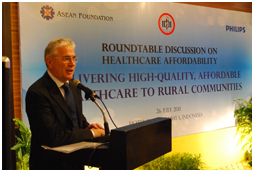Health policies and strategies
The creation of “Healthy Indonesia 2010” forces the Ministry of Health and Social Welfare to forge collaborative relationships with others. As health is a shared responsibility, the Ministry of Health and Social Welfare must involve all strata of the community, all related government departments and agencies, and the private sector. In the effort to achieve “Healthy Indonesia 2010,”the Ministry of Health and Social Welfare must also be proactive and forward-thinking.
The ‘Healthy Indonesia 2010’ goals are:
 To initiate and lead a health orientation of the national development
To initiate and lead a health orientation of the national development
 To maintain and enhance individual, family, and public health along with improving the environment
To maintain and enhance individual, family, and public health along with improving the environment
 To maintain and enhance quality, accessible, and affordable health services
To maintain and enhance quality, accessible, and affordable health services
 To promote public self-reliance in achieving government health
To promote public self-reliance in achieving government health
While the Ministry of Health and Social Welfare was redefining the new Vision and Mission, two new fundamental Acts were enacted, namely Act No. 22/1999 on Local Governance and Act No. 25/1999 on Financial Balance Between Central Government and Local Governments. The two Acts are a reference for the implementation of decentralization policy in Indonesia, which give provinces and districts a large autonomy to manage their own home affairs except defence, monetary and fiscal, foreign affairs, justice, and religion.
Based on the new Vision and Mission of National Health Development and in line with the decentralization policy, it is agreed that there are four paramount issues to serve as the pillars in formulating a Strategy for National Health Development. These are:
 Initiating health-oriented national development
Initiating health-oriented national development
 Professionalism
Professionalism
 Community Managed Healthcare Programme (JPKM)
Community Managed Healthcare Programme (JPKM)
 Decentralization
Decentralization
The identification of these four elements as pillars of the Strategy for National Health Development does not mean that other programmes should not be supported. All programmes and plans of potential assistance to the Ministry of Health and Social Welfare in achieving the new Vision and Mission should be continued, even though these four pillars have the highest priority.
Related Links
Millennium Development Goals (MDGs)
The progress made towards achievement of health related MDGs is given at Annex-2.
Organization of the health system
Structure of the Health System
There are 33 provinces and each province is sub-divided into districts and each district into sub-districts. As decentralization had been already implemented, the 349 regencies and 91 municipalities are now the key of administrative units.
Each sub-district in Indonesia has at least one health centre headed by a doctor, usually supported by two or three sub-centres, the majority of which are headed by nurses. Health centres mainly provide eight programs. Most of the health centres are equipped with four-wheel drive vehicles or motorboats to serve as mobile health centres and provide services to underserved populations in urban and remote rural areas.
At the village level, the integrated Family Health Post provides preventive and promotive services. These health posts are established and managed by the community with the assistance of health canter staff. To improve maternal and child health, midwives are being deployed to the villages.
The Decentralization Policy has been implemented in Indonesia, with the implementation of Act No. 22/1999 regarding Regional Governance and Act No. 25/1999 regarding the financial equality between Central and Regional government. With the implementation of the aforementioned Acts, the government system in Indonesia has been changed from Centralized to Decentralized type of government, which provide regional autonomy. In the Act No. 22/1999, there have been three levels of regional autonomy, i.e., Province, District, and City regional autonomy.
Paragraph 4, sub-paragraph 2 stated that there is no hierarchical links between these three regional autonomy regimes. However, in the explanation of paragraph 4, it is stated that Governor (as Head of Province Regional Autonomy and Head of Administrative area) will have to perform links in guidance, monitoring and supervision to the District and City areas. This is in relation to the delegation of responsibility to Province which has been stated as having limited autonomy; but it has been also given broader de-concentration as representative of Central government. The rule of Guidance and Supervision has been clearly stated in the Government Act No. 20/2001 regarding Guidance and Supervision of Governance implementation applied to local government.
Organizational Structure of Health System
In line with Province government responsibility, Broader Decentralization has been given to District and City levels. Regional government has also been given the authority of “support = perbantuan” or “medebewind”. This has an implication that regional development has to be performed by District/City, while the development at Province level is limited only to those, which have not been covered by District/City, and Inter-district/Inter-city. Meanwhile, the Central government has to perform the role of policy formulation, standards and providing guidance to Province and District/City government levels.
Government Act on Health No. 23/1992 has stated that Health Systems should be implemented by the community with government as facilitator. Private sectors will perform an active role, so that government will act in the provision of guidance and supervision.
Health Information System
A. NATIONAL HEALTH INFORMATION SYSTEMS (NHIS)
National health information systems reforms has been indicated by the development of a new NHIS policy and strategy included in the Ministry of Health decree No. 468/MENKES-KESOS/SK/V/2001, dated 25 May 2001, which has been amended by decree No. 511/MENKES/SK/V/2002, dated 24 May 2002.
Although the NHIS Policy and Strategy has been developed in support of Decentralization on health to achieve Healthy Indonesia by the year 2010, current condition shows that constraints and classical problems have been chronically identified.
Below are the elaboration of vision and mission of NHIS, strength and opportunity, and constraints or challenges (SWOT analysis) of the current NHIS.]
Related Links
A.1 Vision and Mission of NHIS
The vision of NHIS is to support the achievement of Healthy Indonesia by the year 2010. Healthy Indonesia achievement will be accelerated with the provision of accurate, updated and timely presentation of information. Reliable and valid information in other word is a prerequisite for the achievement of Healthy Indonesia 2010. Motto of NHIS VISION is RELIABLE HEALTH INFORMATION 2010.
To support the above vision, the following MISSION of NHIS has been formulated:

The development of data management, which includes data collection, storage and retrieval, and analysis

The development of Data Bank, Health Profiles, and presentations of information for different purposes

The development of networking/sharing information among different data and information users

The development of methods for the use of data and information for action purposes
A.2 Strength and opportunity
The strength and opportunity that will contribute to the development of NHIS are:
Firstly, the strength to support the development of a comprehensive NHIS includes the provision of adequate health infrastructures have been provided by government from national down to sub-district level, different HIS for different purposes have been developed, the initiatives of HIS developed by the unit for local purposes, and the rapid development of Information Technology.
Secondly, there are opportunities which consider will accelerate the development of HIS, which includes Regional Autonomy Implementation which will consider HIS as an important support for the health provider in convincing other health related sectors of its usefulness for decision makers. Structural streamlining organization and empowering professional/functional health personnel, will allow the maximum utilization of HIS personnel. Independency policy of regional health unit with the obligation to provide the quality health services to the community will have to use evidence-based information for decision making purposes.
Considering the aforementioned strengths and opportunities, the development strategy of NHIS consists of the following:

The integration of existing HIS

The streamlining of current procedure and mechanism of reporting and recording systems

The empowerment of regional capacity relating to HIS

The development of HIS human resources, taken into consideration the rapid advance of Information Technology and maintenance of equipment

The provision of adequate information for decision makers and community
For example, at the peripheral level of health management i.e. Health Centre level, apart from illustrating current health problem or situation, information should perform its usefulness as action oriented, which also involve situation analysis for the implementation of programme activity or prompt action to recover the health problems within the area of responsibility.
At the District/Municipality health level, apart from health services delivery monitoring, HIS will also include resources mobilization or relocation, as well as local health system planning and health management improvement
In line with the development of HIS, the improvement of data management should also include integrating data collection, reporting, and use of the information for improving health services effectiveness and efficiency through better management at District/Municipality under decentralized settings.
A.3 Constraints and challenge
Some constraints identified regarding the development of NHIS includes fragmented HIS i.e. different HIS for different programme purposes, lack of regional capacity, minimum use of information for management purposes, minimum use of information by community, minimum usage of Information Technology. These constraints have been more burden to the fact that financial support for the implementation and maintenance of HIS facility and equipment are considered as the least priority in the budgetary line items and provision of an adequate and dedicated HIS personnel is in fact not an evidence in most units either at the point of services or health management level.
B. DISTRICT/CITY HEALTH INFORMATION SYSTEMS
The objective of HIS is to co-ordinate and provide planning and management support to the service delivery levels (Design and Implementation of HIS, WHO 2000)
The most important issue in which the Central Health Systems level can be situated are whether the system in the country is “Centralized” or “Decentralized”; government or private sector-managed systems’ horizontally and vertically managed health services systems. For example: budgeting and decisions on financial allocation will be made at the national level in a centralized system, while it will be delegated to the district/city level in decentralized systems. In a country with a predominantly private sector managed health systems, most of listed health functions are perform by private institutions, while the government only has a regulatory role, setting policies, and making legislation. In a health systems managed mainly through vertically organized health programmes, the manager has taken over responsibilities in resource management and supervision of the line managers.
Health Information Systems, in which District Health Report is one of its important elements, have to be developed in line with decentralization policy on health.
(Technical Guidelines, District/City Health Report under Decentralised Health Systems Implementation, Jakarta, June 2004)
Emergency preparedness
Indonesia is located in an area of the world that experiences regular natural disasters, such as earthquakes, tsunamis, floods, severe droughts and volcanic eruptions. Since the Indonesian archipelago forms a part of the Pacific Ring of Fire, it is prone to earthquakes and volcanic eruptions. The government has since last year been putting 10 of its 129 active volcanoes on “alert” status. In recent years, political, economic, religious and social crises have led to complex emergency situations in several provinces, notably Maluku, North Maluku, NTT (West Timor), Aceh, Sulawesi, Papua and Kalimantan. These civil disturbances have contributed to an increasing number of emergencies in Indonesia in recent years. Both, natural and man-made disasters have resulted in increased mortality and morbidity, as well as a growing population of displaced people.







 that your policy will adequate cover your family members for sickness or accident emergency, whether in Indonesia or when you are returning home on leave or when you are visiting other countries in the course of your work or on vacation.
that your policy will adequate cover your family members for sickness or accident emergency, whether in Indonesia or when you are returning home on leave or when you are visiting other countries in the course of your work or on vacation. member-based plans include medical evacuation as well. These local clinic schemes with medivac coverage that cater to expatriates provide good service and overall you will get good advice from their doctors.
member-based plans include medical evacuation as well. These local clinic schemes with medivac coverage that cater to expatriates provide good service and overall you will get good advice from their doctors. worth noting is that a person could be undergoing outpatient treatment with a very serious illness, which would not be covered under a local clinic scheme.
worth noting is that a person could be undergoing outpatient treatment with a very serious illness, which would not be covered under a local clinic scheme.

 “Philips is deeply committed to delivering affordable solutions to support the sustainability of primary and secondary healthcare needs in Indonesia. Our partnership with the ASEAN Foundation is designed to bring expert collaborators together to engage on the role that innovation and medical technology can facilitate access to healthcare in a cost-effective way,” said Mr Wayne Spittle, Senior Vice-President and Commercial Leader Philips Healthcare Asia Pacific.
“Philips is deeply committed to delivering affordable solutions to support the sustainability of primary and secondary healthcare needs in Indonesia. Our partnership with the ASEAN Foundation is designed to bring expert collaborators together to engage on the role that innovation and medical technology can facilitate access to healthcare in a cost-effective way,” said Mr Wayne Spittle, Senior Vice-President and Commercial Leader Philips Healthcare Asia Pacific. Dr. Pranawa SpPD, K-GH, Chairman of Indonesia Medical Doctors Association, East Java, stated, “Poverty and unprecedented progress in health technologies are identified to have strained our health systems. In entering the new 21st century, our healthcare system should be able to provide a range of services that cover the full continuum of care, keep pace with technological progress and provide health care services to the entire population.”
Dr. Pranawa SpPD, K-GH, Chairman of Indonesia Medical Doctors Association, East Java, stated, “Poverty and unprecedented progress in health technologies are identified to have strained our health systems. In entering the new 21st century, our healthcare system should be able to provide a range of services that cover the full continuum of care, keep pace with technological progress and provide health care services to the entire population.”